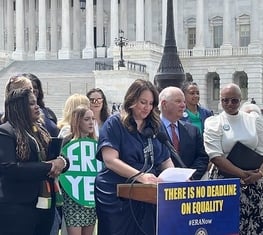Redistricting FAQs
What is reapportionment?
Reapportionment happens every ten years to adjust congressional seats among the 50 states so everyone is fairly represented in the U.S. Congress. The U.S. House of Representatives has 435 seats divided between all 50 states. Each state receives at least one congressional seat. The remaining 385 are divided—apportioned—according to population, as determined by the Census. As the populations of states increase or decrease at varying rates, congressional seats have to be transferred between the states at each reapportionment.
What is redistricting?
Redistricting is the process by which the legislature or other government body redraws the lines and boundaries of electoral districts. This process affects districts at all levels of government, from local school boards and city councils to state legislatures and the U.S. House of Representatives. If a state gains or loses a congressional seat, the redistricting must take this into account. But even if a state doesn’t gain or lose a seat, populations within the state typically shifts sufficiently that district lines must be redrawn, including state legislative seats, municipal districts and school board seats.
Why is the data from the U.S. Census used for redistricting?
The U.S. Constitution requires that the population data for federal reapportionment comes from the Census Bureau. Census data is the most reliable information we have about population changes and using it for redistricting ensures that the principle of one person, one vote is followed.,
Who draws the lines?
Who draws the electoral district lines is decided by each state’s laws. Currently, groups who draw include:
- Independent commission: California and Arizona
- Bipartisan commission: Alaska, Colorado, Hawaii, Idaho, Montana, New Jersey, New York (newly passed initiative), Washington
- Hybrid system: Illinois, Indiana, Maryland, Missouri, Ohio
- A nonpartisan governmental agency: Iowa
- Legislature: the other 34 states
What are the rules for creating new districts?
The rules vary by state, though there are basic federal constitutional and statutory requirement as well. Those who are responsible for redistricting use some or all the following criteria to draw electoral district maps within their state:
- Population equality (Federal requirement)
- Compliance with the Voting Rights Act (VRA) (Federal requirement)
- Contiguity
- Geographic integrity of any city, county, city and county, local neighborhood, or local community of interest
- Compactness
- Nesting
- Consideration of incumbents’ or candidates’ residences
- Competitiveness
Could you explain what these criteria mean?
- Population equality: The “one person, one vote” requirement that political districts have the same number of residents. For congressional districts, the standard is for almost exact equality. The Supreme Court has allowed more flexibility for state legislative districts.
- Compliance with the federal Voting Rights Act: See “What is the Voting Rights Act” below.
- Contiguity: All areas in the district are physically connected to each other.
- Geographic integrity of any city, county, city and county, local neighborhood or local community of interest: To the extent possible, these entities should not be divided and put into different districts.
- Community of interest: A community of interest is a community with shared characteristics, interests, or needs.
- Compactness: Where practicable, districts should not be not too elongated, spread out, or jagged. There are a number of ways to measure compactness.
- Nesting: The practice of drawing lines so that each state Senate district would encompass two state House districts within it, etc.
- No consideration of incumbent or candidate residences: Districts should not be drawn to favor or disfavor a current officeholder or a candidate for an office.
- Competitiveness: Districts where there will be no one political party which can dominate a district’s elections over long periods of time. This can also refer to the total competitiveness of a state – where the total number of votes cast for each political party is roughly equivalent to the number of seats each party receives.
What is the Voting Rights Act?
The Voting Rights Act, also known as the VRA, is a landmark piece of federal legislation that prohibits racial discrimination in voting. It was enacted by Congress in 1965 during the height of the civil rights movement, then amended five times to expand its protections. In 2013, the Supreme Court struck down a portion of the Act (see below).
The Act was designed to enforce the voting rights guaranteed by the 14th and 15th Amendments, and resulted in the mass enfranchisement of racial minorities throughout the country, especially in the South. According to the U.S. Department of Justice, the Act is considered to be the most effective piece of civil rights legislation ever enacted in the country.
The Act contains numerous provisions that regulate election administration. The Act's "general provisions" provide nationwide protections for voting rights. Section 2 is a general provision that prohibits every state and local government from imposing any voting law that results in discrimination against racial, ethnic or language minorities. Other general provisions specifically outlaw literacy tests and similar devices that were historically used to disenfranchise racial minorities.
The Act also contains "special provisions" that apply to only certain jurisdictions. A core special provision is the Section 5 preclearance requirement, which prohibits certain jurisdictions from implementing any change affecting voting policies or procedures without receiving preapproval from the U.S. Attorney General or the U.S. District Court for D.C. that the change does not discriminate against protected minorities. Another special provision requires jurisdictions containing significant language minority populations to provide bilingual ballots and other election materials.
Section 5 and most other special provisions apply to jurisdictions encompassed by the "coverage formula" prescribed in Section 4(b). The coverage formula was originally designed to encompass jurisdictions that engaged in egregious voting discrimination in 1965, and Congress updated the formula in 1970 and 1975. In Shelby County v. Holder (2013), the U.S. Supreme Court struck down the coverage formula as unconstitutional, saying that it was no longer responsive to current conditions. The Court did not strike down Section 5, but without a coverage formula, Section 5 is unenforceable.
What about local redistricting? Should I pay attention?
Yes! All across the country, local political jurisdictions ranging from counties and cities to school boards and special districts also redistrict. Who does or doesn’t get elected often determines who will be a viable candidate for higher office. Monitoring these local jurisdictional processes for the proper application of good redistricting criteria, including transparency and respect for communities of interest, is vital.
How long does redistricting take?
Each state’s laws differ, but those responsible for redistricting can begin work as soon as the official census results reach the state (generally by April of the year following the Census), and must be finished with their work by the deadline set in that state’s laws.
Why should I care about any of this?
How and where the district lines are drawn will determine how strong a voice each voter or each group of voters has in coming elections. It also affects how strong a voice each has when lobbying for or against current or potential laws or budget items.
How can I get involved?
It’s important that elected officials listen to the public, and not just to special interests. So being a part of the process to draw fair districts is crucial for your community. When citizens are left out of the process, it is far more likely that politicians will see that lines get drawn so they can choose their voters, rather than voters being able to choose their elected officials.
The laws in each state differ, and may or may not include any involvement by its citizens. You can still watch, comment, and push for more transparency, as needed. Your voice can help ensure that the redistricting plans adopted by your jurisdiction do not harm your community.
______________________________________
With thanks to the League of Women Voters of California and the League of Women Voters of Oregon. Other sources include U.S. Department of Justice.




